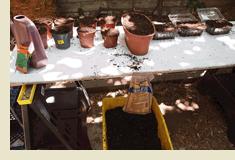My most recent article appeared today in “The Dirt” Troy-Bilt’s monthly newsletter as part of the Saturday6 program. Get your own subscription to The Dirt by signing up on the Troy-Bilt web site.
A Different DIY Garden
By Douglas E. Welch

When most people talk about doing some DIY (do-it-yourself) in their garden, they are usually talking about building something – a wall, a shed, a trellis, whatever. I have thought much the same over the years, but this year I have been concentrating on another aspect of DIY in the garden. My recent DIY projects have consisted of building up the garden itself. This has meant building the soil, building the plantings and building some things you usually buy at the local garden store instead of making yourself.
Building the soil
One ongoing DIY project here in my back garden has been composting. While composting is certainly very popular, I still have many friends who think it is too work-intensive, too troublesome and sometimes too smelly to try themselves. In my case, though, composting is so integrated into my daily routine and my gardening that I don’t even notice it anymore. The bin gets filled with kitchen and brown garden waste and finished compost comes out the bottom. Nothing could be simpler.
Sure, I could go to my local nursery or home store and purchase bags of compost to use in the garden, but as I am sure you know, bagged materials can be quite expensive. In many cases, the cost is simply too high for me to consider. Also, why wouldn’t or shouldn’t I use the materials I already have at hand? I have more than enough leaves, limbs and kitchen waste to create quite a bit of compost. It seems silly to dump it in my city garden bins and then go buy bags of compost to replace it.
My compost has also facilitated a secondary DIY project. Instead of purchasing potting soil to use in containers and start seedlings, I decided to make my own. With all the talk of the unsustainable use of peat in potting soils, I decided to see what I could do using my own compost and a few supplies from the garden store. In my case this involved the simple process of mixing one part homemade compost to one part purchased coconut coir and a quarter-part perlite. There are a number of other potting soil “recipes” available on the Internet – some more complicated, some simpler – for you to try with your own compost.
Building the plants
For many gardeners, the first visit to the nursery each spring is almost a ritual. They pick up their flats of bedding plants – petunias, pansies, etc. – and start bringing the color back into their gardens. I prefer to try and create my own plants from those I already have on the property. It is a bit easier for me since I concentrate on perennials, but starting your annual bedding plants from seed is a great idea, too, and not that difficult, depending on the space you have for starting seedlings and your growing zone.
In my case, some of my plants begin the propagation process without any help from me. The many azaleas in my garden are very happy to start developing new plants through the process of layering. Wherever branches touch the moist ground, azaleas – and other plants – will often start to develop roots. These sections can then be detached from the main plant and potted up for growing or simply transplanted to another area of the garden.
For other plants, I take cuttings and root them in small, recycled containers on my makeshift potting bench. I have done this with rosemary – to create small rosemary topiary bushes – pittosporum and fountain grass. Of course, you can also gather seed from your existing plants and trade them with neighbors, or as I often do, gather seeds from plants you find along your walks. Just yesterday I picked up some wild fennel seeds, which I will try to grow in the garden.
The next time you think about doing a little DIY in your garden, why not reach out to the plants themselves instead of concentrating on the landscape. While building projects can bring some architectural beauty into your garden, I find that developing the soil and developing the plants in my garden is just as important, if not even more important, than building that new trellis or garden wall.